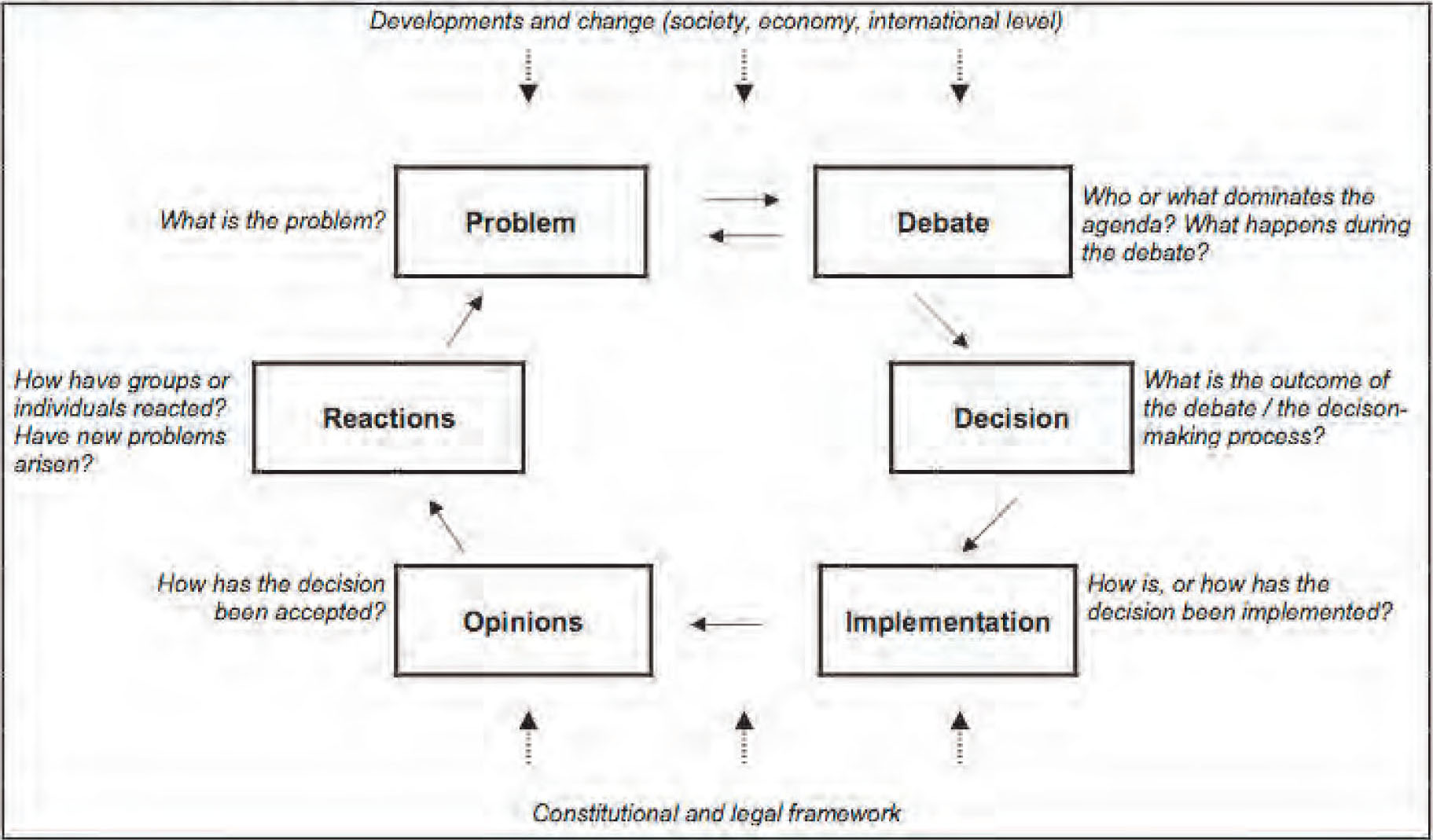| Educational objectives | The students are able to apply the model of the policy cycle to examples of decision-making processes. The students become aware of their opportunities in intervening and participating in processes of decision making. |
| Resources | Set of student handouts: “The policy cycle model”. Flipchart paper, markers, scissors, glue. |
Procedure
- The teacher introduces the model of the policy cycle, using one of the following approaches:
- The teacher employs the deductive, systematic approach: he/she gives a lecture7 and the students apply the tool that they have been given.
- The teacher follows the inductive approach: the teacher begins with an example or refers to knowledge and experience that the students already have. This could be a current issue, a decision that they support or disagree with or a problem that they are worried about. A decision in school can also serve as a starting point. The teacher follows with a lecture, carefully referring to the context provided by the students.
Whatever approach is used, the students receive a copy of the handout “The policy cycle model”.
- The students apply the model. Different tasks can be given:
- The students use the model as a tool for active and structured reading of the newspaper. Working in groups of four to six, the students study the newspapers of the past few days and identify examples for each of the six stages. They paste the articles on their posters and present them in the plenary round.
- The students follow a decision-making process on a particular issue. This may require material covering a longer period of time and therefore older newspapers can be useful too. Books and the Internet can become important sources. This exercise can be developed into a research project.
- The model can serve as a starting point for discussion: in what stages of a decision-making process can we intervene? The teacher should explain that the two stages “decision” and “implementation” are confined to the political system (unless a decision is made by plebiscite). But citizens may intervene in any other stage.
Materials
The policy cicle model: Politics as a process of problem solving

The policy cycle model: background information for teachers
The policy cycle is a model. It works like a map, which means it selects certain aspects from reality and ignores others. In this way the picture becomes clearer but the user should never confuse the model with reality. In this case, the policy cycle model focuses on politics as a process of decision making and solving of problems. Its focus is not on politics as a struggle for power, even though this aspect does appear. The six categories lead to key questions that help to analyse political decision making; the students are encouraged to develop further questions that are more context-specific.
The model gives an ideal type description of political decision-making processes. First, a political problem must reach the public agenda. The issue of agenda-setting has a lot to do with political power. Problems do not exist as such; they must be defined and accepted. Competing interests and values play an important part, as the definition of a problem strongly influences the outcome of decision making. For example, poverty can be defined as an attack on human rights or as an incentive to take one’s fate into one’s own hands. The first view implies that poor people need support, while the second view tacitly recommends not helping poor people too much, as this might make them lazy. The key issue of agenda-setting is indicated by the double arrows between the categories problem and debate.
The debate takes place under certain conditions. The frame of the model is important here: social, economic and international developments set the data. And the constitutional and legal framework defines the rules. Who may take part in the debate? Who deeides what? These questions help to understand the outcome of the debate, the final decision. Who took part in the debate? What interests were at stake? What had to be negotiated? Was it possible to find a compromise?
Implementation: How is, or how has the decision been implemented? Did any difficulties or conflicts occur? Does the implementation meet the intentions of the decision makers?
Opinions: How did the decision “go down”? Whose interests are affected – favourably or unfavourably? What values are involved?
Reactions: Are there reactions by individuals and/or collective, organised reactions by groups? Do they support or oppose the decision? Examples could be protests, demonstrations, letters to the editor of a newspaper, decisions by a court, strikes, emigration, withdrawal of investors, breaking the law, etc.
Problem: At the end of the day has the original problem been solved? Have any undesired or unforeseen effects been produced? Has a new problem arisen through the reactions to the decision and its implementation? The policy cycle is terminated if the problem has been solved. Very often, a new cycle begins with a new subsequent or unforeseen problem.
The students should understand that the policy cycle shows where and how citizens can take part in politics. We can give our definition of problems that need political attention and require public resources to solve them. We can take part in the debate, form our opinion on the decision and support or oppose the way in which it has been implemented. In doing so, we are making use of our human and civil rights. Democracy depends on active democrats.
7. See “background Information for teachers” (in the material section of this exercise).

